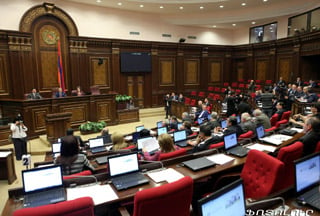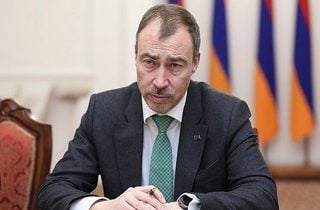The present of the World Bank and international economy to Armenia’s new Prime-Minister

The World Bank has published a report on Armenia, which is entitled “Armenia: Looking for More Dynamism.”
Besides analyzing the economic developments in 2013, the WB’s experts put down forecast for this and next year as well. The report forecasts that this year and in 2015 Armenia’s economic growth rate may be 5%. According to the WB, Armenia’s GDP per capita will be 3,752 dollars this year, and 4,110 next year.
WB experts are optimistic about the RA government’s long-term strategic development project for 2014-2025 as it plans up to 6-7% economic growth and doubled GDP in 2025. The WB estimates this strategy positive as they think the economic recovery following the crisis is slow, and the economy is still sensitive to shocks.
The WB believes changes of prices in the world are not good for Armenia’s economy. According to the report, prices for metals reached a tipping point in the beginning of 2011 but in November 2013 dropped by 30%. In mid-term prospective price dynamics in world markets may create shock for the Armenian economy and reduce its fiscal incomes and export. Inflation has impacted the macroeconomic indicators of Armenia in 2013. The continued slump in the second part of 2013 may impact the economic indicators for 2014.
According to the WB report, the main risk for the Armenian economy is the slow economic development in Russia. The reason is the high level of Armenia’s dependence on financial transfers, investments from Russia and export to that country. The crisis in Ukraine, followed by weakening of the Russian ruble may reduce the volumes of export to Russia and affect other processes, to the extent of making Armenian seasonal migrants to return to Armenia.
Armenia’s export to Europe is significant too, thus the recession of Euro is a potential risk for the Armenian economy.
However, this is not as bad as it may seem to be.
The authors of the report find that the countries with higher incomes will increase the world demand as their growth is becoming faster. According to them, developed countries have overcome the weaknesses of the recent years, and instead of the economic growth of 2.4% in 2013, they will have an average economic growth of 3.2-3.5% in 2014-2016. The fastest economic recovery out of the three main economies (the US, EU and Japan) is happening in the US. Recovery is slower in Europe. However, the pioneer in development in Euro zone will be Germany, which is Armenia’s largest export direction in the EU.
The report forecasts a growth of world demand, as a result of which international trade volumes will increase up to 5.1% in 2016 (as opposed to 3.1% in 2013). According to the report, this will help the developing countries to overcome the implications of high interest rates and slower capital flows. The report writes that Armenia may benefit from a higher foreign demand if it fosters better cooperation with Europe. Probably the word “dynamism” in the report is connected with this recommendation.
It is interesting that the WB is recommending Armenia to develop relations with Europe in case when Armenia’s one foot is already in the Customs Union. The report includes updated information till March 2014. This means the authors of the report do not exclude the possibility that both directions of Europe and the Customs Union may oppose to each other.
The report analyses the benefits and losses Armenia may potentially have from integration with the Eurasia Union. The preliminary analysis was done based on the request of the Armenian government.
WB experts find that import taxes will grow in Armenia. Due to increased import tax the volume of import from third countries will be reduced by 110 million dollars (GDP’s 1%). Only a part of that reduced import will be compensated by import from the Eurasia area. Due to increased prices, the purchasing power of Armenians will be reduced. However, if they increase the tariffs slowly or find another remedy, the transition will be smooth.
Potential benefits will be more visible in the mid-term prospective. Armenia will have more potential for growth if it is able to maintain larger trade cooperation with other parties as well. Theoretically Armenia may become an attractive market for companies interested in investing in the Eurasia Union territory. It depends also on the policies of other participants of the Customs Union. Besides benefits from trade, Armenia will also benefit from lower costs on gas. However, the report does not cover the issue whether benefits from lower gas price can compensate for the losses Armenia may potentially have from joining the Customs Union.
Overall, the World Bank’s forecast is not pessimistic. Even though the WB forecasts 5% economic growth in Armenia, the government has planned real growth of GDP by 5.2% in 2014. WB experts believe the maximum level of economic growth in Armenia can be 5.5% in 2014-2017.
Generally the implications of external factors are becoming weaker, and there are enough conditions for growth. From this point of view the new PM is lucky as if he implements a good policy, he will not fail. In other words, from the economic point of view this is a very good time to become Prime-Minister. However, if the WB’s forecast concerning the international economy becomes reality, the new PM will not be able to justify his failures.
By Babken Tunyan



























